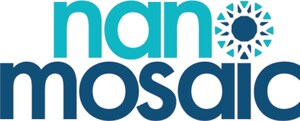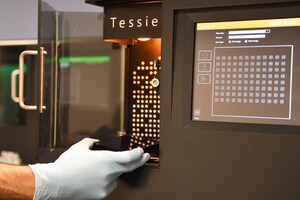NanoMosaic Announces Its Second Commercial Sale of the World's First Proteomics/Multi-Omics System, Tessie™, for Clinical Diagnostic Test Development, Under Its Early Access Program
BOSTON, Feb. 15, 2022 /PRNewswire/ -- NanoMosaic Inc., the pioneer and leader in nanoneedle (MosaicNeedle™) technology detection for proteomics, genomics, and single-run experiment multi-omics applications, has announced its second commercial sale, to Massachusetts General Hospital (MGH) as part of its Early Access Program.
NanoMosaic previously announced that it had placed a beta system at MGH for proteomic neurological diagnostic test development, "NanoMosaic Announces Beta Placement of its Tessie™ System at Massachusetts General Hospital to Run Clinical Samples (prnewswire.com)." Upon achievement of exceptional testing performance metrics, Dr. Zhongcong Xie's group at MGH used the Tessie™ system to run clinical samples in order to screen biomarkers to develop a diagnostic test for post-operative delirium, as well as validate that test across a larger number of clinical samples. Subsequently, MGH requested to purchase the Tessie™ system ahead of the company's official commercial launch.
The company's beta system at MGH has achieved performance metrics of:
- 99% successful run time
- 96% assay success rate
- 6 orders of dynamic range of protein detection
- No upfront sample preparation – samples are loaded directly from serum or plasma
- No fluorescent labels on molecules
- No amplification of target molecules
- Straightforward detection workflow that is amenable to a clinical workflow
- DIY custom content: users are creating custom chips with antibodies from their lab
"The open configuration of the MosaicNeedle™ chip on the Tessie™ platform empowers researchers to develop assays with their own affinity reagents. Simple and robust workflow paves the way for diagnostic applications," said Dr. Qimin Quan, Chief Scientific Officer and Co-Founder of NanoMosaic. "We are excited to see that Dr. Xie's group successfully developed home-brew phosphorylated tau assays on the nanoneedle platform and was able to discriminate phosphorylated tau levels in the delirium and non-delirium patient samples. Predicative biomarkers, such as phosphorylated tau proteins, for post-operative delirium will improve patient care and decrease the risk for the onset of Alzheimer's Disease".
"We are honored to be working with Dr. Xie and his team at Massachusetts General Hospital to advance pre and post-operative surgical care for patients," stated John Boyce, President, CEO, and Co-Founder of NanoMosaic, as well as Co-Founder of Tiger Gene. "With approximately 250MM surgeries performed in the United States, alone, per year and with no actionable diagnostic test available for post-operative delirium, the results that Dr. Xie has achieved on the Tessie system have the potential to drastically improve patient care and decrease complications and long-term health risks associated with surgery," Boyce concluded.
About NanoMosaic
NanoMosaic, a Boston-based biotechnology company, is the first commercial entity to leverage the power of nanoneedles for DIY protein detection and quantification to develop best-in-class assays for biomarker discovery and validation. The NanoMosaic platform, Tessie™, enables coverage of the largest dynamic range while maintaining high sensitivity, multiplexing capabilities and label-free assays. With 1.8 billion MosaicNeedles™ (each equating to a landing site for a protein, resulting in a read) on its current chip format, the NanoMosaic chip enables full proteome interrogation at 7 orders of dynamic range and is able to attain multiplexing levels in the thousands per chip. The proprietary technology enables rapid custom assay development with varying levels of concentrations on a single chip to develop novel biomarkers and push the frontier of the biomarker discovery and diagnostics space.
www.nanomosaicllc.com
Contact: [email protected]
SOURCE NanoMosaic

WANT YOUR COMPANY'S NEWS FEATURED ON PRNEWSWIRE.COM?
Newsrooms &
Influencers
Digital Media
Outlets
Journalists
Opted In






Share this article